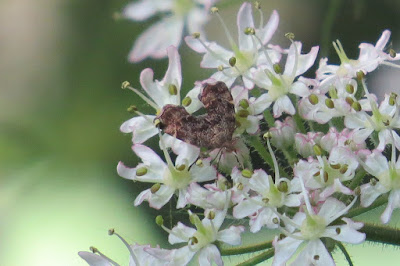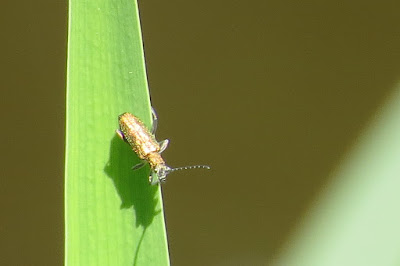A warm late spring morning had barely started when I was in the garden trying to identify the latest insect to fly through the bathroom window overnight. It was a species of Cranefly, and I am fairly confident that the species involved was the Spotted Cranefly
Nephrotoma appendiculata.
 |
| Nephrotoma appendiculata |
Like several of the craneflies I have seen it seems to have lost a leg at some stage during its life.
Today I decided to leave the confines of our garden in search of insects, specifically to kick-start my dragonfly list, by wandering up the road to Ipsley Alders nature reserve.
I was still kicking through the grassy border of Alders Drive when I disturbed an attractive day-flying moth, the Mother Shipton.
 |
| Mother Shipton |
I am quite familiar with this species, so named because of the hook-nosed witch pattern on its forewing, from seeing it regularly at Morton Bagot.
I eventually cut through the gap into the woodland surrounding the reserve. After walking past an apparently dead Tree Bumblebee I spotted another cranefly. This was another one I hadn't seen before, namely
Tipula luna.
 |
| Tipula luna |
There were so many insects to look at I realised I would need to be fairly selective, or I'd never make any progress. I recognised a micro-moth from seeing one at Morton Bagot last year. This was the Nettle-tap Moth.
 |
| Nettle-tap Moth |
One I will probably never identify was a leaf-mine left in leaves below knee-level. They will presumably have been caused by a leaf-mining moth. It would probably have helped if I had troubled myself to identify the leaf.
Although I have promised myself not to get into beetles (too difficult and too many species) a bright red one reminded me of a species I had identified as the Cardinal Beetle
Pyrochroa serraticornis when I last noticed one, at Upton Warren in 2015.
 |
| Pyrochroa serraticornis |
By now I was approaching the pools, and it wasn't too long before I was seeing damselflies. There were several Blue-tailed Damselflies, and many Azure Damselflies and Large Red Damselflies all in the process of mating and egg-laying.
 |
| Blue-tailed Damselfly |
 |
| An orgy of Large Red Damselflies |
 |
| Azure Damselflies |
Also associated with the pond side vegetation was a small beetle. After considerable research I have concluded it is probably the species
Donacia vulgaris.
 |
| Donacia vulgaris |
Ipsley Alders is a lovely reserve, and the citizens of Redditch are very fortunate to have it on their doorstep. However, the pool is full of Carp which attracts the occasional fisherman. Evidence of their presence can be seen in the numerous floats left abandoned in the pond. This is regrettable but probably accidental littering, but I'm sorry to say the pool does attract a lot of beer cans and I even found a couple of arm chairs fly-tipped there. The reserve deserves better respect from its visitors.
 |
| Disappointing ! |
Returning to the insect life, I saw only one butterfly today, but it was new for the year. A Green-veined White.
 |
| Green-veined White |
I tend to photograph only male damselflies because the females are largely dull and similar to one another. Many of the Azures and Blue-tailed were flying up into the overhanging trees, which was where I saw a couple of unidentified female or immature damselflies like this one. I believe it to be the immature brown form of Blue-tailed Damselfly.
As I surveyed the pond I finally saw my first dragonflies of the year. A male and female Broad-bodied Chaser were patrolling the edge of the pool, the female clearly egg-laying. Only the male posed for a photograph though.
 |
| Broad-bodied Chaser |
I think I would argue that this is the most stunning British dragonfly. Very easy to identify. I then spotted a large spider on its web in the reed and thought that it was so distinctive looking that it should be a cinch to I.d. Not so. It was an orb-web spider and was probably the species
Tetragnatha extensa but the reference I found warned that there were several near identical species which could only be safely separated by examination of their genitalia under a microscope. A good reason not to get into spiders.
 |
| Tetragnatha sp |
Birds have not been mentioned at all up to now. I heard several Whitethroats, Blackcaps, Chiffchaffs, and Goldcrests singing but nothing that inspired me to divert from bug-hunting.
The walk back produced a final beetle, this time along Alders Drive. It was
Oedemera nobilis otherwise known as the Swollen-thighed Beetle, a species which is common at Morton Bagot.
 |
| Oedemera nobilis |
Thus ended an action-packed hour and a half. I will certainly be returning while the sun continues to shine.
















No comments:
Post a Comment